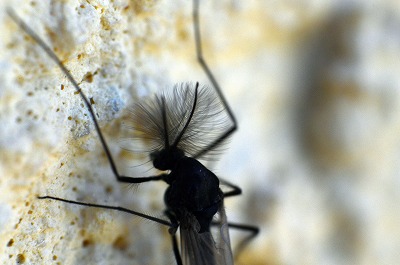ユスリカ

ユスリカは、ハエ目ユスリカ科に属する昆虫で日本に約500種いると言われています。
ユスリカ成虫の体長は1〜11mmと結構幅広いのですが、工場などで問題となるのは5mm以下の微細で弱々しい種が多いです。
ユスリカの幼虫は身近な小水域(側溝や排水溝、用水路、庭の水溜まりなど)から湖沼や河川、競艇場などといった大水域まで、ありとあらゆる水域に生息し、水中や水底の有機物を餌として、特に都市部やその近郊の汚れた水域(側溝や用水路など)で大量に発生します。
敷地内に排水処理施設を持つ工場では、ほぼ間違いなくその沈殿槽がユスリカの発生源となっています。
多くの都道府県における工場排水の水質基準は、BOD(生物化学的酸素要求量)が20ppm程度ですが、この程度の水質がユスリカの発生に最も適していると言われています。
これより清浄であっても、汚染度が高くてもユスリカの成育には適さないようです。
ちなみにこれより汚染度が高くなると今度はチョウバエ発生の好適条件となります。
成虫は屋外で最も多く見られる飛翔性昆虫の一つで、正の走光性が非常に強いため、工場から漏れる光に大量に誘引されます。
そして、微小で飛翔力があまりない種が多いので、工場が陰圧だと工場内に気流とともに吸い込まれてしまいます。
このように光に強く誘引され、且つ飛翔力がそれほど強くないという性質のため工場の光源およびバリア機能(間隙等)の指標となります。
ユスリカは外部から工場内に侵入しやすいので、製品への異物混入の問題も非常に多い昆虫です。
異物として発見された場合は、虫体が破損し、欠損していることが多いため、種まで特定できることは少ないです。
ユスリカは食品だけでなくフィルムなどの包装資材や紙などの表面に圧着することが他の昆虫と比べて顕著に多いです。
ラインや中間製品付近の照明に誘引されて落下する場合がほとんどですが、偶発的に製品に迷入、あるいは付着することもあります。
これには原料や中間製品の露出時間と露出部のサイズの大きさが影響していると考えられます。
ユスリカの防除対策としては、幼虫対策と成虫対策があります。
幼虫対策では工場敷地内で発生させないことが重要となりますので、発生源を除去したり、場合によっては昆虫成長制御剤(IGR)などの殺虫剤を使用し、生息密度を低下させます。
いっぽう成虫対策としては、敷地を含む工場全域の光源管理(ライトコントロール)、屋外から重要管理エリアまでに間仕切りを多く設ける(ゾーニング)、陽圧化により屋内外の差圧を調整する(気流コントロール)などが挙げられます。
成虫は光に強く誘引されますので、ライトトラップによる捕殺は非常に効果があります。
ユスリカのライフサイクルがよくわかる動画です。
ユスリカ関連書籍
ユスリカ対策
Chironomid (Midge, or Non-biting midge)
Chironomids (also called midges or non-biting midges) are insects that belong to the family Chironomidae, and it is said that there are over 500 species in Japan. Chironomid adults have a fairly wide body length of 1 to 11 mm, but many chironomids commonly found in factories are tiny and weak (mostly 5 mm or less).
Chironomid larvae inhabit all kinds of waters from small waters (ditches, drains, irrigation canals, pools of gardens, etc.) to large waters such as lakes, rivers, and boat races. It occurs in large quantities in dirty water areas (gutters, irrigation canals, etc.) in urban areas and its suburbs. At factories that have wastewater treatment facilities on site, the settling tank is arguably the source of chironomids. The water quality standard for factory effluent in many prefectures is BOD (biochemical oxygen demand) of about 20 ppm, but it is said that this level of water quality is most suitable for the occurrence of chironomids. It seems that it is not suitable for the growth of chironomids, even if it is cleaner than this degree or has a higher degree of pollution. By the way, if the degree of pollution is higher than this degree, then it will be a suitable condition for the occurrence of moth flies.
Adults are one of the most common flying insects found outdoors and have a very strong positive phototaxis, so numerous of them are attracted to lights leaking from factories. And since there are many species that are minute and do not fly very well, if the factory is under negative pressure, it will be sucked into the factory with the airflow. Because of these characteristics, adult chironomids can be an indicator of the light source and barrier function (structural gaps, etc.) of the factory.
Since chironomids easily enter the factory from the outside, they often cause foreign matter contamination in products. If found as foreign substances, their bodies are often damaged and missing, and it is too hard to identify the species. Compared to other insects, chironomids are significantly more likely to be crimped not only on food but also on packaging materials such as films, plastic containers, and the surface of papers. Most of the cases, chironomids are attracted to the light near the production line or intermediate products and fell on the intermediate products or finish products, but it may accidentally get in or stick to the products. It is considered that this is correlated with the exposure time and the size of the exposed part of raw materials or intermediate products.
As control measures for chironomids, there are measures against larvae and adults. Since it is important to prevent the occurrence of larvae in the factory premises, it is necessary to remove the source or, in some cases, to use IGR (insect growth regulators) to reduce population density. On the other hand, there are some physical measures against adult insects such as UV light control throughout not only inside the factory building but sites, zoning using many partitions from the outdoors to important control areas, and airflow control that adjusts the differential pressure inside and outside by positive pressure. Adults are strongly attracted to light, so capturing them with light traps is very effective.








